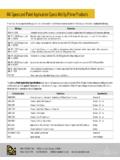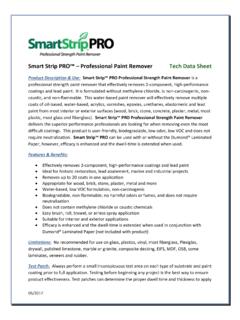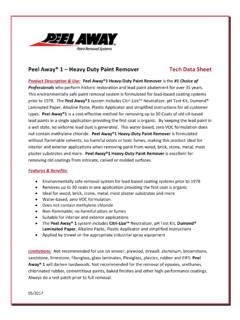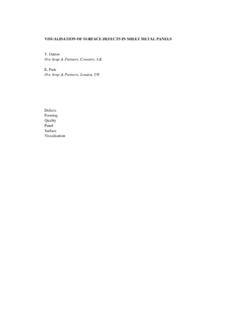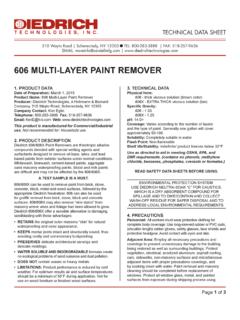Transcription of Guide to Maximizing Spray Paint Adhesion
1 Guide to Maximizing Spray Paint Adhesion Introduction The world of Paint has come a long way since its origin. We not only have a myriad of color options, but there are also far more Paint types available focused on specific applications. However, the purpose of Paint remains the same: improve protection and aesthetics. Unfortunately, Paint Adhesion remains a challenge. In spite of the many improvements in Paint technology, manufacturers have not yet been able to overcome all problems related to Adhesion . Nevertheless, companies requiring a painted surface for a product have the ability to ensure maximum Paint Adhesion by correcting or avoiding common pitfalls. This Guide to Maximizing Spray Paint Adhesion provides tactics to improve Adhesion by addressing trouble spots in the painting process. PRIME PRODUCTS, INC. 2755 Remico, , Wyoming, MI 49519. Phone: Fax: www. 2. Substrates Paint Adhesion Differs Paint quality begins with the substrate. Some substrates, such as Teflon or polypropylene are best to avoid.
2 There are many options for paintable substrates including ferrous metals, galvanized metals, aluminum, plastics and composite materials. These substrate materials have different properties and as a result, have different capabilities to bond with the Paint . Therefore, it is critical to use a Paint designed to bond with the material's specific properties. Type of Paint Understanding the composition of the substrate is important; however, understanding how that material will ultimately be used is a critical component when determining Paint Adhesion criteria. Exposure to chemicals, UV's, abrasion, or any other environment specific condition plays a key role in Paint formulation. There is a vast array of paints and Paint additives available in the market today, with new innovations occurring regularly. This diversity of selection allows users to select a Paint with characteristics that are ideally suited for virtually any requirements. Whether you're working with a high heat, require flexibility, or a super tough finish, taking the time to select the optimal Paint will ensure a robust finish.
3 Shape of Part A part's shape or profile can also prove challenging for Spray Paint Adhesion . Deep pockets can be difficult to Spray Paint , so consider masking these areas to keep them free from Paint . Sharp corners are prone to Paint chipping, so consider adding a radius or chamfer to these edges. PRIME PRODUCTS, INC. 2755 Remico, , Wyoming, MI 49519. Phone: Fax: www. 3. Cleaning: The Key to Paint Adhesion The importance of a clean part whether its substrate is metal, plastic or composite cannot be over emphasized. The slightest bit of dirt, mold release agents, rust, oil, or solvents left on a part creates the likelihood of problems with Paint adhering to its surface. Therefore, it is critical to thoroughly clean parts using cleaning systems appropriate for the substrate. Cleaning systems vary in degree and application such as ultrasonic cleaning, immersion washing, degreasing and others. Some cleaning systems such as the ones in the next section also treat the substrate surface.
4 Preparing the Part Surface Sandblasting or liquid honing a part prior to painting to increase the surface roughness is an excellent way to promote Paint Adhesion . These processes may also help reduce the need for other deburring methods. Liquid honing is preferred on most plastic parts, particularly clear plastic that will be made into an illuminated part, because it is cleaner process and less heat is introduced, both of which help avoid any discoloration of the substrate. There are several choices to ensure good Paint Adhesion when it comes to pre-finishing metal parts such as aluminum. Two popular and effective choices are chem film and anodizing. Chem film, also known as chemical conversion coating, is a process that applies a chromate conversion coating primarily on aluminum and aluminum-related alloys. This process promotes good Paint Adhesion while conducting an electrical charge and provides some protection from corrosion. Anodizing is another process aiding in Paint Adhesion .
5 Like chem film, anodizing is primarily used with metals such as aluminum, titanium or magnesium parts. This process provides greater protection from corrosion. By immersing in an acid electrolyte bath, the part is coated with aluminum oxide. This coating delivers a surface hardness compared to that of a diamond and provides excellent Paint Adhesion . PRIME PRODUCTS, INC. 2755 Remico, , Wyoming, MI 49519. Phone: Fax: www. 4. Primers The Tie That Binds After a part is thoroughly cleaned and conditioned, an important next step is the application of a primer coat. The primer serves a dual purpose in Paint Adhesion protecting a metal substrate from corrosion and bonding the topcoat of Paint to the substrate. Select a primer based upon the part's use (high or low wear) and environment (interior, clean atmosphere to intense environment settings with high pollution levels or exposure to salt water) to ensure maximum Paint Adhesion over time. Some primers perform best when the topcoat is applied within a specified range of time.
6 If the maximum time limit is exceeded then the topcoat Adhesion may be poor unless the primed surfaces are scuff sanded and cleaned prior to topcoat application. Plasma/Corona Treatment Powerful Surface Adhesion Plasma/corona treatment is another substrate preparation process used primarily for plastics. This process incorporates corona discharge plasma making changes (cleaning) of the substrate surface to remove contaminants and prepare the surface to bond better with Paint . Utilizing a strong blown arc discharge, this treatment drastically improves overall Adhesion on various surfaces. This is ideal applications such as printing, painting, coating, bonding, and labeling. The blown arc plasma is created by the blowing of atmospheric air past two high voltage power electrodes. This blowing is often referred to as corona treatment. The electrical discharge from the blowing of the arc positively charges any ion particles that are close by. Then by direct contact, these particles then create a positive charge of the object's surface where it's been treated.
7 At this point, the surface is more receptive to surface coatings such as Paint or ink. PRIME PRODUCTS, INC. 2755 Remico, , Wyoming, MI 49519. Phone: Fax: www. 5. How Proper Paint Preparation Affects Adhesion With a primer coat applied, the next step is the application of the Paint . Applying a topcoat of Paint to a part requires a level of precision to prevent problems with Paint adherence. First, make sure that two-component paints, meaning those that require a catalyst or hardener, have been mixed precisely per the manufacturer's instructions. Second, thinner should be added to achieve the desired Paint viscosity. This may vary depending on the equipment used and the desired gloss level and texture of the finished product. Third, take note of and follow the suggested induction time for the Paint . This is the time required for base and converter components to chemically cross-link, making separation from the primer coat less likely. Spray Gun Selection and Configuration There is a need for specialization when it comes to selecting the correct Spray gun.
8 The density of paints require multiple Spray guns to save time, prevent contamination when switching from one Paint type to another and to deliver a quality finish. Additionally, proper sizing of the Spray gun for the application affects the delivery of the Paint and ultimately, the quality of the finish. For example, a Spray gun designed for touchup will not work for other applications and vice versa. Upon selection of the correct gun, make sure the fan width is correct for the application. The three-digit number on the Spray tip determines fan width. In other words, if the three-digit number is .517, the first number (5) is multiplied by two. This indicates that at a distance of 12 from the part, the fan width is 10 . Tip size is based upon the material sprayed. A. smaller tip size is better for low viscosity Paint products and heavier viscosity coatings perform better with larger tip sizes. Air pressure also plays a role in delivering a quality finish.
9 The intensity of air pressure is measured in cubic feet per minute (CFM) and depends upon the application. When spraying, use the lowest pressure that still atomizes the coating. Spray guns typically operate in a range between 2and 18 CFM with a typical setting of 12 CFM. PRIME PRODUCTS, INC. 2755 Remico, , Wyoming, MI 49519. Phone: Fax: www. 6. How to Properly Apply the Coating and Handling The technique used when applying the Spray Paint will vary depending on the Paint preparation, Spray gun selection and even the environmental conditions. The distance, angle, speed, air pressure, fan width and number of passes are all variables that must be adjusted to achieve the desired coverage, mil thickness, gloss level and texture. The right application technique is also critical in avoiding common Spray painting defects such as runs, drips or dry Spray . Once the part receives its coating, proper handling is required to prevent issues with the finish. Improper handling will result in contaminants falling on the wet Paint , damaging the finish and increasing the likelihood of Adhesion problems.
10 In many commercial settings, parts move through a Paint booth on a hanging conveyor thereby avoiding manual handling of the wet parts until after curing in the ovens. Curing the Painted Parts Most paints will be dry to the touch well before they are fully cured. Baking the parts is a common method for accelerating the curing process. The oven temperature and bake time are set according to the Paint manufacturer's specifications. For many paints the same results can be achieved by baking the part longer at lower temperatures, so always check to make sure the bake temperature that is selected will not damage the product. PRIME PRODUCTS, INC. 2755 Remico, , Wyoming, MI 49519. Phone: Fax: www. 7. Subcontracting to a Pro As this Guide has illustrated, Spray painting done well requires the right equipment and expertise. Therefore subcontracting the Paint finish to an experienced professional is often times a smart choice. Key considerations when choosing a contractor include: Accreditation: S ome projects require the contractor to hold industry recognized accreditations to perform special processes such as Spray painting.
